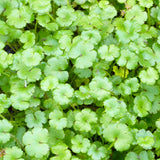Myriophyllum Spicatum Aquatic Pond Plant - Upright Water Milifoil
Myriophyllum spicatum, commonly known as Eurasian Watermilfoil, is an aquatic plant species that is native to Europe, Asia, and North Africa. It is now considered an invasive species in many parts of the world due to its aggressive growth and ability to outcompete native plants. Here is a detailed description and care guide for Myriophyllum spicatum:
Description:
Myriophyllum spicatum is a submerged aquatic plant with long, feathery leaves that are arranged in whorls around the stem. The leaves are typically dark green in color and finely divided into many thread-like segments. The stems can grow up to several meters in length, with the top portion emerging from the water's surface. The plant produces small, inconspicuous flowers that are usually reddish or greenish in colour.
Care Guide:
Water Requirements: Myriophyllum spicatum prefers full sun to partial shade and thrives in calm or slow-moving freshwater bodies like ponds, lakes, and streams. It can tolerate a wide range of water conditions, including slightly acidic to alkaline pH levels. Maintain a water temperature between 20-25°C (68-77°F) for optimal growth.
Lighting: Provide ample lighting for Myriophyllum spicatum. If growing indoors, use full spectrum aquatic plant lights. In outdoor ponds, ensure that the plant receives at least 6-8 hours of direct sunlight each day.
Substrate: Myriophyllum spicatum can be grown in a variety of substrates, including sand, gravel, or a nutrient-rich aquatic planting media. Ensure that the substrate is well-aerated and allows the roots to establish a firm hold.
Nutrient Requirements: Provide regular fertilization to promote healthy growth. Use a specialized aquatic plant fertilizer that contains essential nutrients like nitrogen, phosphorus, and potassium. You may also add iron-rich supplements to prevent yellowing of leaves.
Water Movement: This plant prefers gentle water movement. Avoid strong currents or turbulent areas as they can uproot or damage the plant.
Pruning and Maintenance: Regularly prune Myriophyllum spicatum to control its growth and prevent it from spreading excessively. Remove any dead or decaying leaves or stems to maintain water quality and prevent nutrient buildup.
Controlling Invasive Spread: If you are growing Myriophyllum spicatum in an outdoor pond, be cautious as it can become invasive and crowd out other aquatic plants. Regularly monitor the plant's growth and remove any fragments or clippings to prevent its spread to other water bodies.
Pests and Diseases: Myriophyllum spicatum is generally resistant to pests and diseases. However, it can occasionally be affected by fungal infections or algae overgrowth. Maintain good water quality and consider using algaecides or fungicides if necessary. Note: It is important to check and comply with local regulations regarding the cultivation and control of Myriophyllum spicatum, as it may be listed as an invasive species in some regions.
Please keep in mind that Myriophyllum spicatum can be highly invasive and may require specific permissions or permits for cultivation or removal in some areas. Be sure to research and follow the guidelines and regulations in your region to prevent any negative impacts on the environment.
Selection of Plants:
Choose appropriate oxygenating plants that are suitable for the size and depth of your pond. Common oxygenating plants include Hornwort (Ceratophyllum), Anacharis (Elodea canadensis), Waterweed (Elodea densa), and Watermilfoil (Myriophyllum species).
Placement:
Place oxygenating plants in the water at a depth where their foliage is fully submerged. Distribute the plants evenly throughout the pond, ensuring they receive adequate sunlight for photosynthesis.
Water Quality:
Oxygenating plants play a crucial role in maintaining good water quality by absorbing excess nutrients, competing with algae for resources, and releasing oxygen through photosynthesis. Regularly monitor water quality parameters such as pH, ammonia, nitrite, and nitrate levels to ensure they are within suitable ranges for the plants.
Nutrient Levels:
Oxygenating plants benefit from moderate nutrient levels in the water, but excessive nutrients can lead to rapid algae growth. Avoid over-fertilization or excessive organic matter accumulation in the pond, as it can negatively impact oxygenating plants.
Pruning and Maintenance:
Regularly thin out and prune oxygenating plants to prevent overcrowding and ensure healthy growth. Remove any dead or decaying plant material promptly to maintain water quality and prevent the release of excess nutrients.
Winter Care:
Some oxygenating plants may need special attention during winter, especially in colder climates. If your pond experiences freezing temperatures, consider moving potted plants indoors or provide insulation to protect them. In milder climates, oxygenating plants may continue to grow during winter, providing oxygen and supporting the pond ecosystem.
Propagation:
Some oxygenating plants can be propagated by dividing or taking cuttings. Follow specific instructions for each plant species to propagate them successfully and maintain a healthy population in your pond.
Monitoring and Control:
Regularly observe the growth and condition of oxygenating plants to identify any signs of disease, pests, or nutrient deficiencies. If needed, control excessive growth by removing excess plant material, but be careful not to remove too much at once, as it can disturb the pond's ecological balance.
Introduction of New Plants:
Before introducing new oxygenating plants into your pond, ensure they are free from pests, diseases, or invasive species. Avoid introducing non-native species that may become invasive and harm the local ecosystem. By following these general tips and care guidelines, you can maintain healthy oxygenating plants in your pond. They will contribute to the overall oxygenation of the water, provide habitat for beneficial organisms, and promote a thriving pond ecosystem.
































